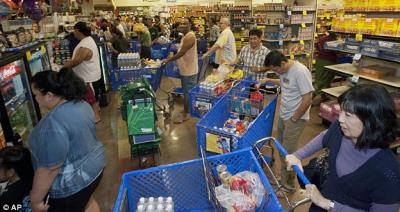Momentous events have a way of changing perceptions and altering personal and business routines and activities. The unprecedented demand for eggs is a case in point. Over the past three weeks, national egg inventory has declined successively over a range of 9.7 to 12.6 percent, reducing stock in some cases to the bare floors of coolers. Demand has risen by 40 percent and Midwest wholesale prices have vaulted by over 150 percent.
 Consumers are depleting supermarkets shelves with their transition to an “eat-at-home” lifestyle. Supermarkets are pressured to replenish tray-pack chicken, eggs, shelf-stable milk substitutes, paper goods, and toiletries. Demand for eggs has transcended all categories, although some price sensitivity is evidenced by the fact that “pasture reared” and similar products, priced upwards of $6 per dozen remain unsold. Nationally-branded specialty eggs, house brands and generics are whisked off shelves to consumers’ refrigerators throughout the nation. In accordance with the laws of supply and demand, price has risen in response to availability with an average national price now exceeding the three year average, following a very depressed 2019.
Consumers are depleting supermarkets shelves with their transition to an “eat-at-home” lifestyle. Supermarkets are pressured to replenish tray-pack chicken, eggs, shelf-stable milk substitutes, paper goods, and toiletries. Demand for eggs has transcended all categories, although some price sensitivity is evidenced by the fact that “pasture reared” and similar products, priced upwards of $6 per dozen remain unsold. Nationally-branded specialty eggs, house brands and generics are whisked off shelves to consumers’ refrigerators throughout the nation. In accordance with the laws of supply and demand, price has risen in response to availability with an average national price now exceeding the three year average, following a very depressed 2019.
There are a number of observations and lessons from the increased demand for eggs since the advent of COVID-19:
- The distribution system from packing plants through to supermarket shelves cannot respond adequately to surges in demand. Out-of-stock represents a lost sale and in turn revenue to a retailer and ultimately a reduction in the potential increase in per capita consumption.
- In visiting supermarkets over the past few weeks, it is evident that stores receiving direct delivery are more able to keep shelves stocked. In contrast, there appears to be a delay interposed by distribution centers that have not reacted to the surge.
- As with manufacturing industries, the obvious risks and costs associated with “just-in-time” management are becoming apparent. What works under an optimal situation has proven to be inefficient when challenged by increased demand.
- Retailers will have to maintain more stock and motivate their deli personnel to transfer eggs from coolers to shelves as necessitated by volume of sales.
- More frequent deliveries from DCs to stores are obviously necessary with an emphasis on critical items. This may result in a deterioration in cost per ton-mile, but may well be justified in terms of enhanced store revenue and consumer satisfaction. Evidently, chains must become more flexible with regard to sourcing supplementary deliveries direct from packers, especially if they are unable to receive deliveries through company DCs.
A situation such as Covid-19, which has resulted in a profound shift in dining from QSRs and restaurants to the home, has highlighted the versatility of eggs. Not only due to the reality that most consumers can cook an egg, be it boiled, fried, or scrambled, consumers have now extended from breakfast to lunches and even dinners. A stay-at-home lifestyle mandated by COVID-19 restrictions is probably bringing more families together to eat and the industry should experience an increase in demand after the present crisis is resolved. Publicity generated by the American Egg Board emphasizing eggs as a source of protein and other nutrients and their excellent use of social media to promote diversity of meals that can be prepared with eggs should reinforce an obvious consumer trend.
Since shopping at large supermarkets may be regarded as a risk of acquiring COVID-19, smaller stores including Dollar and convenience units are now regarded as locations to buy eggs, milk, bread, and other necessities. This trend may persist when normal conditions return. Accordingly, distributors involved in restocking these stores may play an important role in maintaining an anticipated increase in egg consumption.
Pack size may well be influenced by demand, favoring 18 and 24-egg presentations. Fewer visits to supermarkets require larger packs to maintain volume of sales. More eggs in the refrigerator will probably translate to greater consumption.
The final lesson relates to willingness to pay. It is possible that this episode of high demand and concurrent escalation in price will create a greater appreciation of the value of eggs and an inclination to pay for their inherent nutrients. Not only are we retraining a cohort of consumers, but we may in fact be recalibrating chain buyers who are essentially the arbiters of price.
There are probably many lessons to be learned from the current situation, as stressful and unfortunate as it may be. Again, EGG-NEWS stresses the need for a professional study on egg pricing under unusual marketing conditions. Previously, it was suggested that the AEB fund studies by agricultural economists to examine price and supply relationships in the shell egg and liquid masrkets and their interaction during and following the 2015 avian influenza epornitic. The COVID-19 demand is yet another opportunity for the industry to take advantage of market perturbation to learn more about how demand and supply influence price in the short and intermediate term. This will allow more rational decisions on allocation of capital for expansion and cage-free transition, flock placement and marketing programs to capitalize from both normal and abnormal situations.